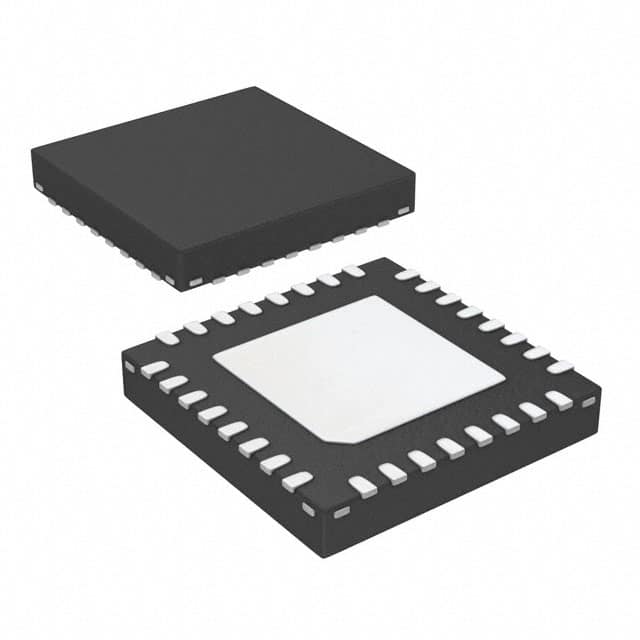EFM8LB11F16E-B-QFN32
Product Category
The EFM8LB11F16E-B-QFN32 belongs to the category of microcontrollers.
Basic Information Overview
- Use: This microcontroller is designed for use in embedded systems, IoT devices, and industrial applications.
- Characteristics: It features low power consumption, high performance, and a wide range of integrated peripherals.
- Package: The EFM8LB11F16E-B-QFN32 comes in a QFN32 package.
- Essence: Its essence lies in providing a versatile and efficient solution for embedded system development.
- Packaging/Quantity: The microcontroller is typically supplied in tape and reel packaging with a quantity of 2500 units per reel.
Specifications
- Core: 8051-compatible 8-bit microcontroller core
- Clock Speed: Up to 50 MHz
- Flash Memory: 16 KB
- RAM: 2 KB
- Operating Voltage: 1.8V to 5.25V
- I/O Pins: 28
- Communication Interfaces: UART, SPI, I2C
- Analog-to-Digital Converter (ADC): 10-bit SAR ADC
Detailed Pin Configuration
For detailed pin configuration, please refer to the official datasheet provided by the manufacturer.
Functional Features
- Integrated Peripherals: The microcontroller integrates various peripherals including timers, PWM, comparators, and GPIOs, reducing the need for external components.
- Low Power Modes: It offers multiple low-power modes, enabling energy-efficient operation for battery-powered applications.
- Flexible Communication: With UART, SPI, and I2C interfaces, it facilitates seamless communication with other devices.
Advantages and Disadvantages
- Advantages:
- Low power consumption
- High clock speed
- Rich set of integrated peripherals
- Disadvantages:
- Limited flash memory compared to some competing models
- Relatively higher cost compared to entry-level microcontrollers
Working Principles
The EFM8LB11F16E-B-QFN32 operates based on the 8051-compatible microcontroller architecture, executing instructions and handling input/output operations to control connected devices and perform various tasks within embedded systems.
Detailed Application Field Plans
This microcontroller is well-suited for a wide range of applications including: - IoT devices - Home automation systems - Industrial control systems - Sensor nodes - Smart appliances
Detailed and Complete Alternative Models
- EFM8LB10F8G-A-QFN20
- EFM8LB12F64E-B-QSOP24
- EFM8LB1F64E-B-QFN32
In conclusion, the EFM8LB11F16E-B-QFN32 microcontroller offers a balance of performance, power efficiency, and integrated features, making it an ideal choice for diverse embedded system applications.
Word count: 398
Senaraikan 10 soalan dan jawapan biasa yang berkaitan dengan aplikasi EFM8LB11F16E-B-QFN32 dalam penyelesaian teknikal
What is the EFM8LB11F16E-B-QFN32 microcontroller used for?
- The EFM8LB11F16E-B-QFN32 microcontroller is commonly used in applications such as industrial control, home automation, and IoT devices.
What are the key features of the EFM8LB11F16E-B-QFN32 microcontroller?
- The EFM8LB11F16E-B-QFN32 microcontroller features a high-performance 8051 core, low power consumption, and a wide range of peripherals including ADC, DAC, timers, and communication interfaces.
How does the EFM8LB11F16E-B-QFN32 microcontroller handle low power requirements?
- The EFM8LB11F16E-B-QFN32 microcontroller incorporates various low-power modes and features to optimize power consumption, making it suitable for battery-powered applications.
What development tools are available for programming the EFM8LB11F16E-B-QFN32 microcontroller?
- Silicon Labs provides a comprehensive suite of development tools including Simplicity Studio, which supports code development, debugging, and energy profiling for the EFM8LB11F16E-B-QFN32 microcontroller.
Can the EFM8LB11F16E-B-QFN32 microcontroller communicate with other devices?
- Yes, the EFM8LB11F16E-B-QFN32 microcontroller supports various communication interfaces such as UART, SPI, and I2C, enabling seamless integration with other devices in a system.
What are the recommended operating conditions for the EFM8LB11F16E-B-QFN32 microcontroller?
- The EFM8LB11F16E-B-QFN32 microcontroller typically operates within a specified voltage and temperature range, ensuring reliable performance in diverse environments.
How can the EFM8LB11F16E-B-QFN32 microcontroller be programmed and debugged?
- The EFM8LB11F16E-B-QFN32 microcontroller can be programmed and debugged using standard interfaces such as JTAG or C2, supported by compatible programming/debugging tools.
Does the EFM8LB11F16E-B-QFN32 microcontroller have built-in security features?
- Yes, the EFM8LB11F16E-B-QFN32 microcontroller offers hardware-based security features such as a unique device identifier and a memory protection unit to enhance system security.
What are the typical applications where the EFM8LB11F16E-B-QFN32 microcontroller is utilized?
- The EFM8LB11F16E-B-QFN32 microcontroller is commonly employed in motor control systems, sensor interfaces, smart meters, and other embedded control applications.
Are there any known limitations or considerations when using the EFM8LB11F16E-B-QFN32 microcontroller?
- While the EFM8LB11F16E-B-QFN32 microcontroller offers a wide range of features, users should consider factors such as memory size, clock speed, and peripheral compatibility when designing their technical solutions.


